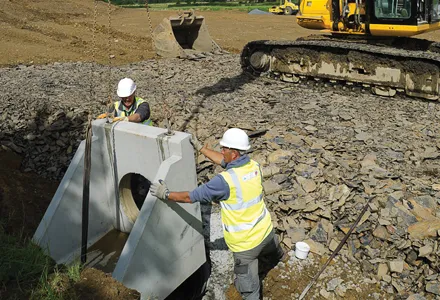More than 100 of Kijlstra’s precast concrete headwalls are being used on a trunk road improvement in South West Wales. They were said to be chosen are being used on Welsh Government’s €69.72 million (£56.7mn) St Clears to Red Roses upgrade for their eco-friendly, health and safety and time/cost/waste saving benefits. The standard Type 1 headwalls are being installed by main contractor SRB Civil Engineering (a joint venture between Roadbridge and John Sisk & Son). They are being connected to both concrete an
January 3, 2013
Read time: 3 mins

More than 100 of
The standard Type 1 headwalls are being installed by main contractor SRB Civil Engineering (a joint venture between
They are being connected to both concrete and plastic pipework (although they can also connect to clay pipes) along the carriageway, in what is said to be a particularly undulating area of Carmarthenshire.
The improvement is being delivered under an Early Contractor Involvement contract between the Welsh Government and SRB Civil Engineering.
The 9.3km scheme will bypass the villages of Llanddowror and Red Roses, cross the River Hydfron and pass through several environmentally sensitive areas including the Taf Valley.
It includes the construction of 120,000m² of road surface, five over-bridges, six underpasses and the Afon Hydfron river bridge. Detailed design and construction work began in February 2012 and is expected to complete in January 2014.
The A477 trunk road is an important part of the Welsh Government’s strategic road network in south west Wales linking the M4 motorway to the ferry port of Pembroke Dock. It also plays an important role in the local road network giving access to south Pembrokeshire.
Between St Clears and Red Roses the existing A477 is said to have poor alignment and visibility, narrow carriageway and verges where present and limited safe overtaking opportunities affect journey time reliability and road safety. Within Llanddowror and Red Roses there are properties close to the trunk road which suffer traffic noise, but their proximity to the carriageway limits the opportunity for improvements.
Stephen Salvin, construction manager at SRB Civil Engineering, said: “Using precast concrete headwalls reduces our carbon footprint as there is no longer any need to bring concrete lorries to site to pour in-situ.
“We are reducing the carbon emissions per unit by between 49% and 60% and are eliminating the associated material wastage we have on traditional construction methods. It is also less labour intensive which speeds the whole drainage process as well as minimising health and safety risks.”
Salvin said the headwalls can also be installed in environmentally sensitive areas without any issues arising from the use of wet concrete using traditional methods. He added: “This was a major factor influencing the purchase of these types of headwalls on this scheme. There are also significant cost savings in the use of the precast headwall system.”







